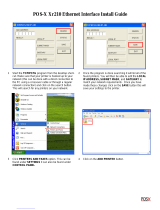
8
Overview ............................................................................................................................................
236
Accessing the Audit Log feature ........................................................................................................
236
Annotation (Bates Stamping).............................................................................................................
237
Overview ............................................................................................................................................
237
Configuring Bates Stamp Settings.....................................................................................................
237
Configuring a precise Bates Stamp location......................................................................................
238
Internet Services.....................................................................................................................................
239
Enable Internet Services (HTTP) C3..................................................................................................
239
To access Internet Services Settings at the Device ..........................................................................
239
Internet Services (HTTP) Enablement...............................................................................................
240
Internet Services Port Number.......................................................................................................
240
Exiting the Internet Services Selection Menu ................................................................................
240
Exiting the Port Settings Menu and returning to the Device's Main Menu.....................................
240
Overview N1.0....................................................................................................................................
241
Status Tab N1.01 ..............................................................................................................................
242
Jobs Tab N1.1....................................................................................................................................
243
Print / Scan Tab ...................................................................................................................................
244
Properties Tab N1.3.............................................................................................................................
245
Descriptions of the individual hot links in the Directory Tree .............................................................
245
Descriptions of the File Folders in the Directory Tree .......................................................................
247
Support Tab N1.5 ................................................................................................................................
248
Additional Details of some Properties Tab features........................................................................
249
Setting TIFF (and other PDL) Processing Properties N3.2 ...............................................................
249
Setting PDL Emulations N3.3............................................................................................................
250
Set the Ethernet Speed N5.0.............................................................................................................
251
Configure NetWare Settings N5.2 .....................................................................................................
252
Configure TCP/IP Settings N5.3........................................................................................................
254
TCP/IP Configuration Selection List...............................................................................................
255
Configure LPD N5.6.........................................................................................................................
257
Configure SNMP N5.4......................................................................................................................
258
SNMP Community Name properties that can be configured .........................................................
258
Configuring SNMP Community Names with Internet Services..........................................................
258
Configure SMB N5.5........................................................................................................................
259
Configure IPP N5.7 ..........................................................................................................................
260
Modify the HTTP (Internet Services) Settings N5.8...........................................................................
261
Configure Port 9100 (Raw Printing) N5.9 ..........................................................................................
262
Restricting Device Access N.5.8.2.....................................................................................................
263
Configure EtherTalk (AppleTalk) N5.10 ............................................................................................
264
E-mail, SMTP, and POP3 Settings ....................................................................................................
265
Bonjour...............................................................................................................................................
266
Troubleshooting......................................................................................................................................
267
General Troubleshooting Procedure.................................................................................................
267
TCP/IP Troubleshooting T1 ................................................................................................................
269
Check Physical Media and Network Interface Cards ........................................................................
269
Print a Settings List at the Device and perform these tasks:.............................................................
269
At the workstation, perform these tasks:............................................................................................
270
NetBEUI Troubleshooting T2 .............................................................................................................
272
Check Physical Media and Network Interface Cards ........................................................................
272
Print a Settings List at the Device and perform these tasks:.............................................................
272
At the workstation, perform these tasks:............................................................................................
273
NetBIOS over IP Troubleshooting T3................................................................................................
275
Check Physical Media and Network Interface Cards ........................................................................
275
Print a Settings List at the Device and perform these tasks:.............................................................
275
At the DNS or WINS Server...............................................................................................................
276
At the NT Server, if being used to Queue Jobs to the Printer ...........................................................
276
At the workstation, perform these tasks:............................................................................................
277





















